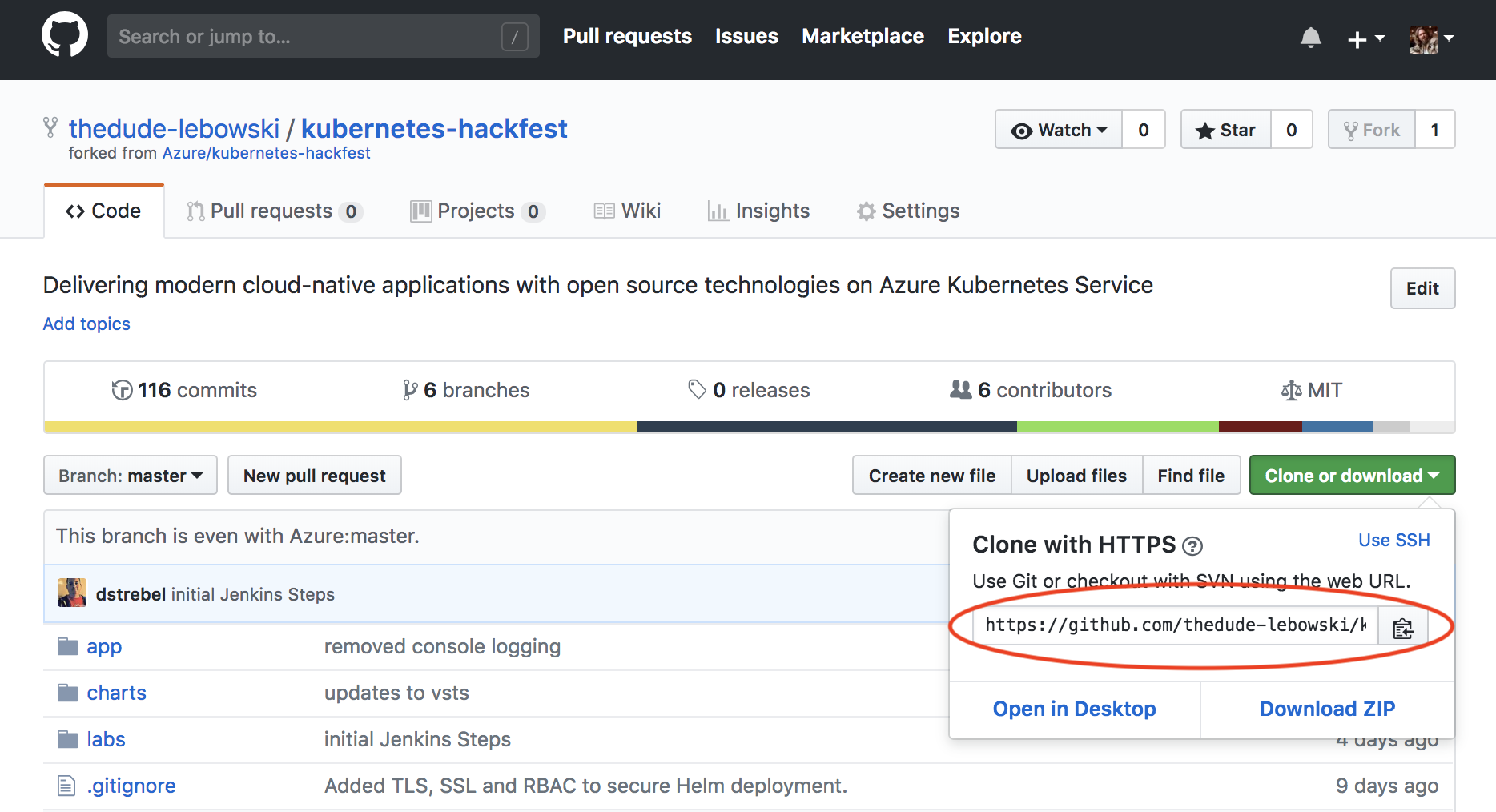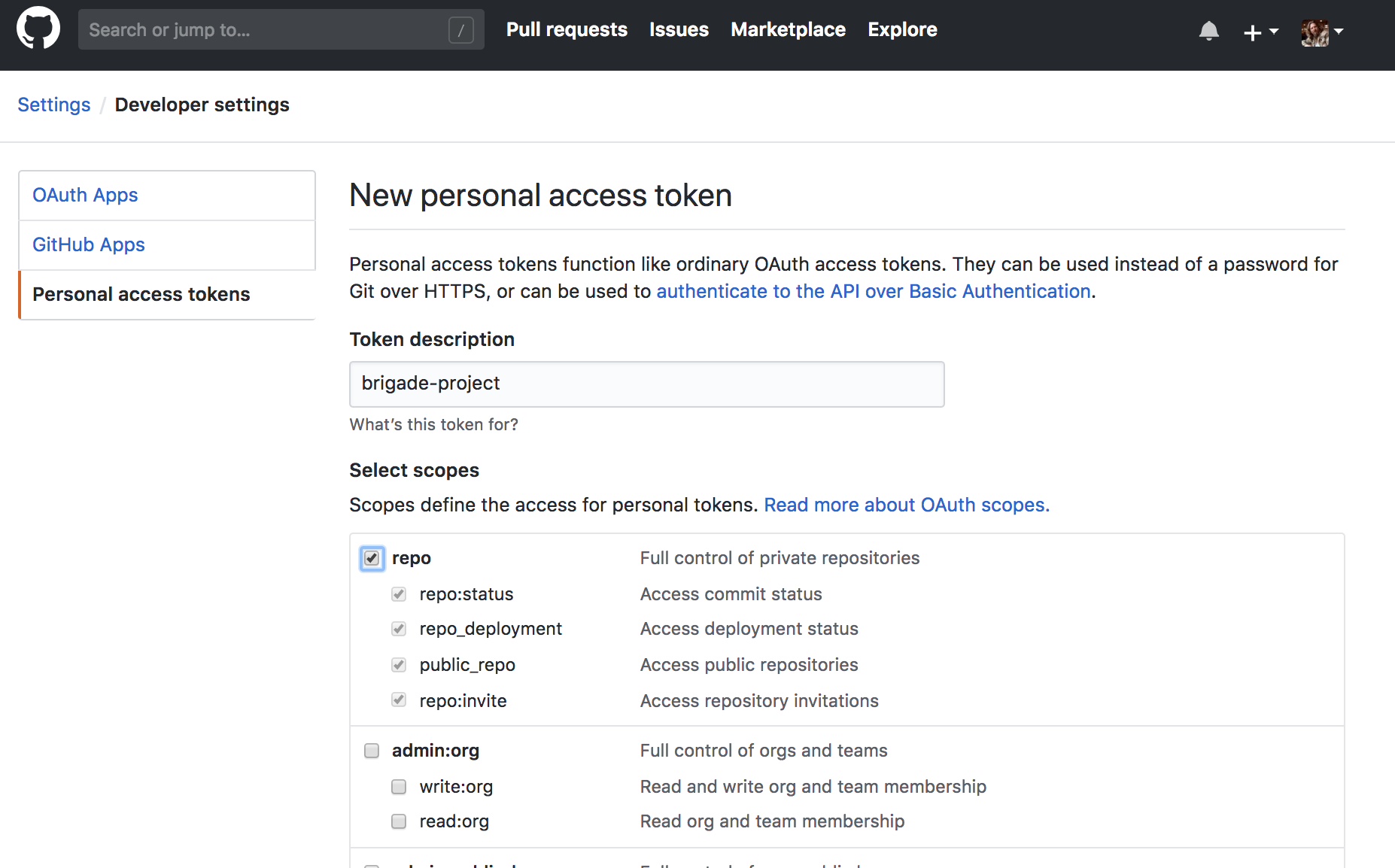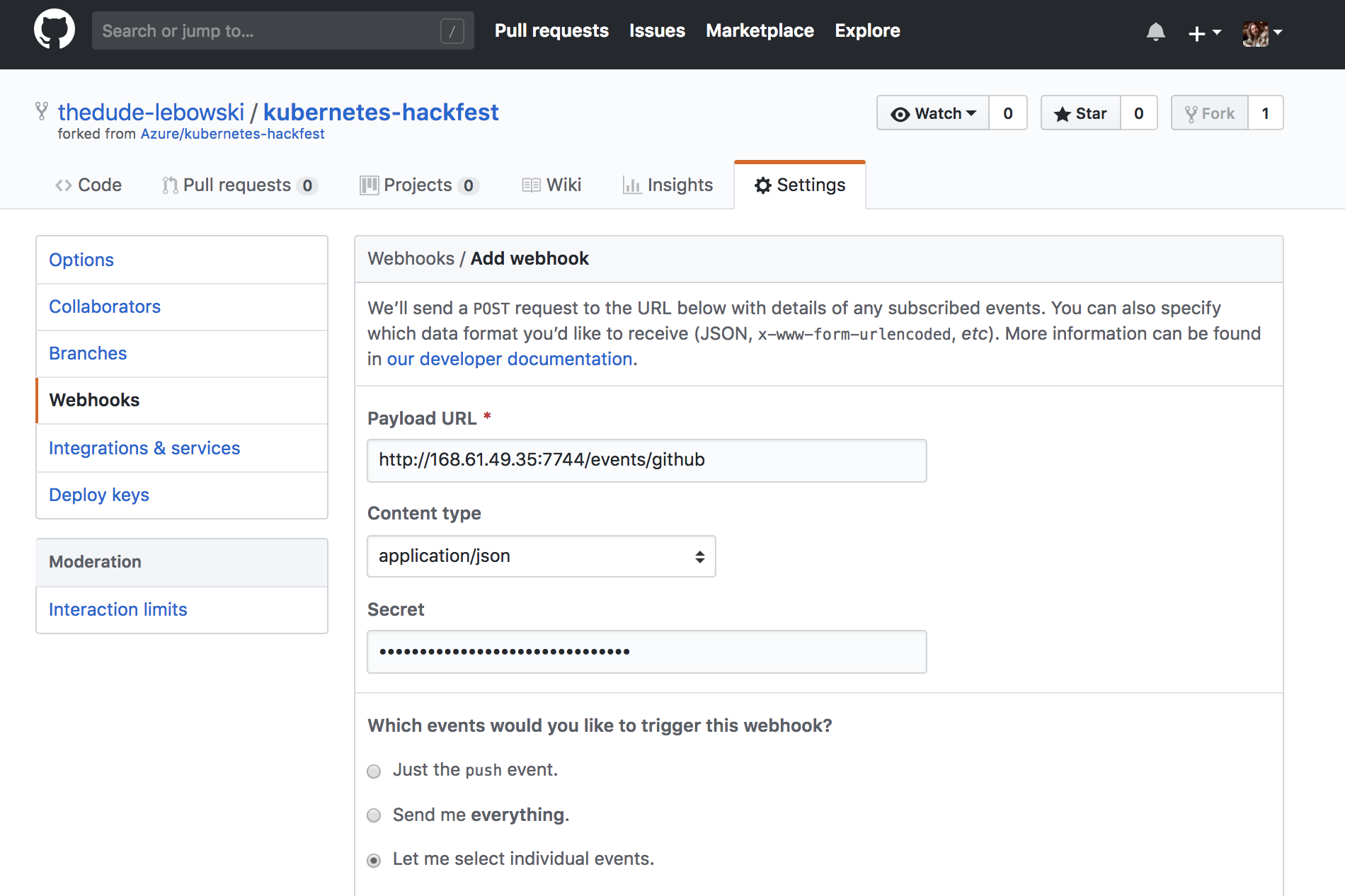kubernetes-hackfest
Delivering modern cloud-native applications with open source technologies on Azure Kubernetes Service
Lab: CI/CD with Brigade and Helm
This workshop will guide you through building a Continuous Integration (CI) and Continuous Deployment (CD) pipeline using the open source platform Brigade. The pipeline will utilize Azure Container Registry to build the images and Helm for application updating.
Prerequisites
- Complete previous labs:
Instructions
The general workflow/result will be as follows:
- Push code to source control (Github)
- Trigger a continuous integration (CI) build pipeline when project code is updated via Git
- Package app code into a container image (Docker Image) created and stored with Azure Container Registry
- Trigger a continuous deployment (CD) release pipeline upon a successful build
- Deploy container image to AKS upon successful a release (via Helm chart)
- Rinse and repeat upon each code update via Git
Setup Github Repo
In order to trigger this pipeline you will need your own Github account and forked copy of this repo. Log into Github in the browser and get started.
-
Broswe to https://github.com/azure/kubernetes-hackfest and click “Fork” in the top right.

-
Grab your clone URL from Github which will look something like:
https://github.com/thedude-lebowski/kubernetes-hackfest.git
-
Clone your repo in Azure Cloud Shell.
Note: If you have cloned the repo in earlier labs, the directory name will conflict. You can either delete the old one or just rename it before this step.
git clone https://github.com/<your-github-account>/kubernetes-hackfest.git cd kubernetes-hackfest
Setup Brigade
-
Update helm repo
helm repo add brigade https://brigadecore.github.io/charts - Apply the cluster role binding for the brigade-worker service account
kubectl apply -f labs/cicd-automation/brigade/brigade-rbac.yaml -
Install brigade chart into it’s own namespace
kubectl create ns brigade helm install brigade brigade/brigade --namespace brigade --set brigade-github-app.enabled=true --set brigade-github-app.service.type=LoadBalancer kubectl get pod,svc -n brigade NAME READY STATUS RESTARTS AGE pod/brigade-brigade-api-77d8c6cd59-grlcw 0/1 Running 0 8s pod/brigade-brigade-ctrl-5885799bcd-zmxjx 1/1 Running 0 8s pod/brigade-brigade-github-app-597b756478-dkx84 1/1 Running 0 8s pod/brigade-kashti-7d46999bb9-zgf7t 1/1 Running 0 8s NAME TYPE CLUSTER-IP EXTERNAL-IP PORT(S) AGE service/brigade-brigade-api ClusterIP 10.0.85.60 <none> 7745/TCP 8s service/brigade-brigade-github-app LoadBalancer 10.0.189.63 <pending> 80:31744/TCP 8s service/brigade-kashti ClusterIP 10.0.52.160 <none> 80/TCP 8s
Setup Brigade Project
Brigade uses projects to define the configuration for pipelines. Brigade Projects are also installed with a Helm chart. In this section, we will create a YAML file to configure the brigade project Helm chart.
-
Create a brigade project YAML file.
-
Create a file called
brig-proj-hackfest.yamlKeep this file local on the cloud shell. This is a sensitive file and should not be pushed to Github.Note: In the latest Azure Cloud Shell, there is a built-in editor to allow easy file editing without leaving the shell.
-
Add the contents below to start your file
project: repository: cloneURL: sharedSecret: github: token: secrets: acrServer: acrName: appId: password: tenant: - Edit the values from above to match your Github account (example below)
- project: thedude-lebowski/kubernetes-hackfest
- repository: github.com/thedude-lebowski/kubernetes-hackfest
- cloneURL: https://github.com/thedude-lebowski/kubernetes-hackfest.git
- sharedSecret: useSomethingSuperSecretForThis!
- Create a Github token and update the
brig-proj-hackfest.yaml- In your Github, click on
SettingsandDeveloper settings - Select
Personal sccess tokens -
Select
Generate new token
- Enter
brigade-projectfor the description and give access to therepo
Note: More details on Brigade and Github integration are here: https://github.com/Azure/brigade/blob/master/docs/topics/github.md
- Be sure to copy the access token value and add it to your project YAML file.
- In your Github, click on
- Gather your ACR info from the Azure portal. Edit the
brig-proj-hackfest.yamlfor these values- acrServer (something like myacr.azurecr.io)
- acrName (something like myacr)
- Create an Azure service principal with rights to your ACR Resource Group.
-
You can get your subscription ID in the Azure portal or running
az account list -o tableexport AZSUBID="471d33fd-a776-405b-947c-467c291dc741" export RGNAME=kubernetes-hackfest az ad sp create-for-rbac --role="Contributor" --scopes="/subscriptions/$AZSUBID/resourceGroups/$RGNAME" # mock values: { "appId": "11pp69f2-2d9a-4c46-921c-99058df3738z", "displayName": "azure-cli-2018-01-10-21-20-18", "name": "http://azure-cli-2018-01-10-21-20-18", "password": "11111fe4-07dd-4adb-b984-d25f030f7a92", "tenant": "99f999bf-99f1-41af-99ab-2d7cd011ab12" } - Be sure to grant the service principal rights to the RG where your ACR is located.
- Use the output to set the values in the
brig-proj-hackfest.yamlfile
-
-
After the above steps, your file will look like the below (values are not valid for realz)
project: thedude-lebowski/kubernetes-hackfest repository: github.com/thedude-lebowski/kubernetes-hackfest cloneURL: https://github.com/thedude-lebowski/kubernetes-hackfest.git sharedSecret: useSomethingSuperSecretForThis! github: token: 1yyy8a4d1c08004rrttt685980814d3f358e5b0z secrets: acrServer: myacr.azurecr.io acrName: myacr appId: 11pp69f2-2d9a-4c46-921c-99058df3738z password: 11111fe4-07dd-4adb-b984-d25f030f7a92 tenant: 99f999bf-99f1-41af-99ab-2d7cd011ab12
-
-
Create your brigade project
# from the directory where your file from step #1 was created helm install brig-proj-hackfest brigade/brigade-project -f brig-proj-hackfest.yaml --namespace brigadeNote: There is a
brigCLI client that allows you to view your brigade projects. More details here: https://github.com/Azure/brigade/tree/master/brig
Setup Brigade Pipeline
To save time, we will only deploy the web-ui application in this lab.
-
In the Azure cloud shell,
cd ~/kubernetes-hackfestand create a file calledbrigade.js -
Edit
brigade.jsin cloud shell -
Paste the contents from the sample brigade.js file in this file
-
Review the pipeline steps in the javascript
-
Commit the new file to your Github repository
git add . git add -A git commit -m "added brigade pipeline script" git pushNote that we are using the master branch here. Normally we would use other branches and PR’s. For simplicity, we are using master just for this lab.
Configure Github Webhook
-
Get a URL for your Brigade Gateway
kubectl get service brigade-brigade-github-app -n brigade NAME TYPE CLUSTER-IP EXTERNAL-IP PORT(S) AGE brigade-brigade-gw LoadBalancer 10.0.45.233 13.67.129.228 7744:30176/TCP 4h # use these commands to create the full URL export GH_WEBHOOK=http://$(kubectl get svc brigade-brigade-github-app -n brigade -o jsonpath='{.status.loadBalancer.ingress[0].ip}')/events/github echo $GH_WEBHOOKThe webhook URL should look something like: http://13.67.129.228/events/github You will use this in the next step.
-
In your forked Github repo, click on Settings
-
Click Webhooks
-
Click
Add webhook -
Set the
Payload URLto the URL created in step 1 -
Set the
Content typetoapplication/json -
Set the
Secretto the value from yourbrig-proj-hackfest.yamlcalled “sharedSecret” -
Set the
Which events...toLet me select individual eventsand checkPushandPull request
-
Click the
Add webhookbutton
Test the CI/CD Pipeline
-
Make a code change in the web-ui application source code.
-
Push the update to Github and validate the build in brigade.
kubectl get pod -n brigade NAME READY STATUS RESTARTS AGE brigade-brigade-api-789bf79dbd-t2p8g 1/1 Running 0 1d brigade-brigade-ctrl-5d85d9f5bc-txwz4 1/1 Running 0 3h brigade-brigade-github-gw-65f45c69c7-8r2qw 1/1 Running 0 3h brigade-worker-01cjzdd4dnssjp50chw2fps6h3 0/1 Completed 0 31m brigade-worker-01cjzdn7d650jff10a04292pjs 0/1 Completed 0 1m job-runner-acr-builder-01cjzdd4dnssjp50chw2fps6h3 0/1 Completed 0 31m job-runner-acr-builder-01cjzdn7d650jff10a04292pjs 0/1 Completed 0 1m job-runner-helm-01cjzdd4dnssjp50chw2fps6h3 0/1 Completed 0 31m job-runner-helm-01cjzdn7d650jff10a04292pjs 0/1 Completed 0 25s kubectl logs job-runner-helm-01cjzdn7d650jff10a04292pjs -n brigade # Note: On the above command you can add the -f flag to 'follow' the output (i.e. to keep watching it as it rolls) -
Check the
service-tracker-uiapplication pods and ensure they were updated with the new imageTag created in the build. -
If it worked, celebrate and go get a beer.
Add Kashti Web Dashboard (Optional)
The Kashti Web Dashboard was deployed as part of the Brigade Helm chart. By default the dashboard service is set as ClsuterIP. You can edit the service and change the type to LoadBalancer to view the dashboard.
kubectl edit svc brigade-kashti -n brigade
Troubleshooting / Debugging
- N/A
Docs / References
- Brigade web site
- [Brigade Source] https://github.com/Azure/brigade
- Original Blog Post